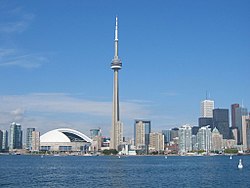Geography of Ontario
Its physical features vary greatly from the Mixedwood Plains in the southeast to the boreal forests and tundra in the north.
Located within the Golden Horseshoe, Toronto is the capital of Ontario, the financial centre of Canada, and the country's most populous city.
[2] Southwestern Ontario and a narrow strip along the coast of the Saint Lawrence River are in the Mixedwood Plains, a fertile and productive ecozone that is typically flat with rolling hills, and was once covered by forest before its use for agriculture, and later urbanization, resulted in deforestation of vast swaths of the area.
The plains that cover the heartland of Ontario are a transitional ecozone characterized by boreal features in the south and tundra landscapes in the north.
[11] The central region of the Shield, known as the Grenville Province and located south of Sudbury, is 1.0 to 1.6 billion years old and is dominated by sedimentary rocks showing evidence of being subjected to metamorphism.
The border with Quebec is defined by a line due north of the head of Lake Timiskaming to James Bay,[15] and southeast from there, the Ottawa River for about 620 km (390 mi).
The land in the North-east and North-west, generally north of Lake Superior, is the Canadian Shield where most of Ontario's highest points are found.
[citation needed] Further south, many hilltops of the Algonquin, Haliburton and Madawaska Highlands, which are also part of the shield that covers much of the north, surpass altitudes of 500 m (1640').
Ontario's vast rivers and lakes originally opened the province for exploration and have made possible hydroelectric power, mills and various forms of industrialization.
Some cities straddle the zone boundary, such as London, the upper part of Hamilton, and Cornwall in Southeastern Ontario.
In the fall and winter, temperatures are moderated by the delayed cooling of the Great Lakes; this effect is reversed in spring and summer when afternoon warming is tempered.
Both spring and fall generally consist of mild days and cool nights but are prone to drastic temperature changes over a short timespan.
Upland areas in this region have cooler conditions, examples would be Mount Forest and Bancroft, generally more precipitation (especially snowfall), putting them firmly into the Dfb climate scheme.
Most of Southern Ontario lies in the lee of the Great Lakes, producing abundant snow in some areas: (London, Goderich and Barrie, for example) receive an average of over 2 m (80") annually, while some other areas are not in the direct line of snowbelt activity can receive on average less 1 m (40") of snow per year, such as in Chatham and Brantford.
This region has warm and humid summers but with more variability, a much shorter growing season with cold, longer winters with roughly equal annual precipitation to the south.
In summer, hot weather occasionally reaches even the northernmost parts of Ontario for brief periods, although humidity is generally lower than in the south.
Surprisingly warm to hot temperatures sometimes occur in Northern Ontario communities when there is a long flow of wind from the south, as happened on 10 May 2022 when Moosonee recorded Canada's first 30 °C or 86 °F reading of the year.
Thunderstorms form from daytime convective heating and frontal activity; in the south, lake breeze convergences also intensify storms.
During periods of hot weather in summer, they often develop in the afternoon west of the Great Lakes then strike Southern and Central Ontario at night with great forward motion, bringing severe straight-line winds over wide areas resulting in damage to forests, power interruption and infrastructure damage.
In Northern Ontario, some tornadoes go undetected by ground spotters because of the sparse population and remote landscape; they are often discovered after the fact by aircraft pilots, where aerial observations of damaged forest confirm occurrences.



